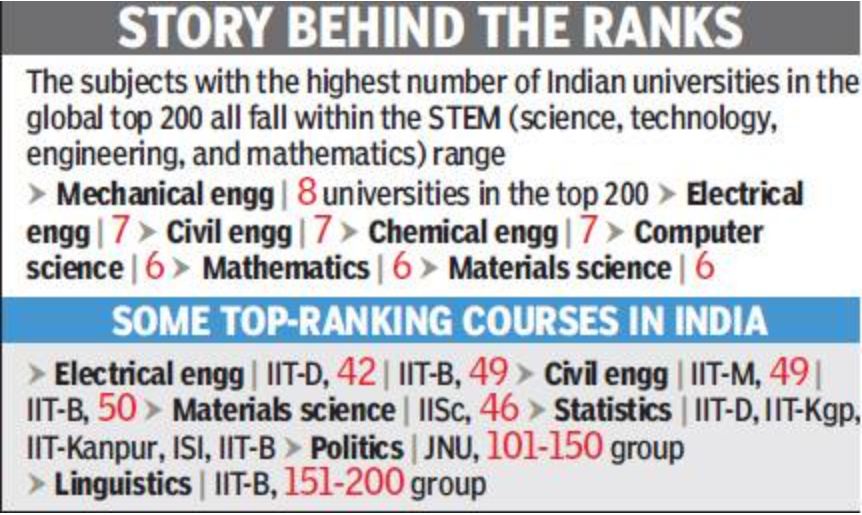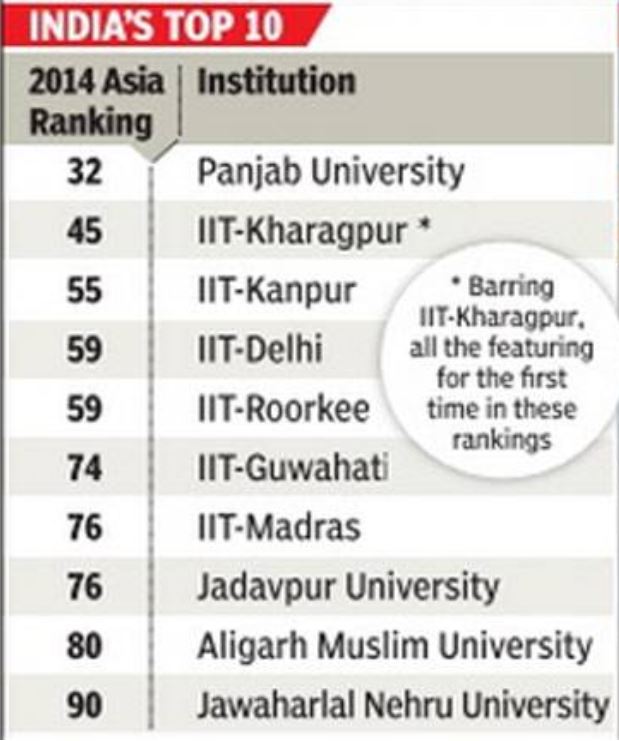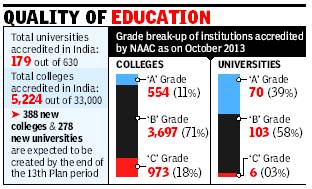Indian universities: global ranking
This is a collection of articles archived for the excellence of their content. Readers will be able to edit existing articles and post new articles directly |
2012: IITs put India on world map
The IITs in global rankings
IITs put India on world map / 3 Institutes Feature In Top 50 Global Univs For Engg Courses
Kounteya Sinha , The Times of India 2013/05/09
London: IIT Delhi’s electrical engineering department has been ranked the 37th best globally, the highest entry from India across all categories in the latest Quacquarelli Symonds (QS) world university rankings.
QS is a reputed British education and career advice company, which, until 2010, produced the rankings with the Times Higher Education.
The IIT Bombay’s civil engineering department has been ranked 39th while IIT Delhi’s mechanical and aeronautical engineering department has been positioned 43rd. Indian Institute of Science ranks 50th in materials science.
IITs have come as the only saving grace for Indian universities in the rankings released on Wednesday. Not a single university or department has made it to the top 200 altogether in 12 of the 30 disciplines covered in the global rankings.
Important subjects without a single Indian institution featuring in the top 200 include medicine, law, economics and education.
The best performances from Indian universities came in the field of engineering, as expected. IIT Bombay, IIT Delhi and IIT Madras are all ranked in the global top 50 in at least one of the four areas of engineering: civil, mechanical, electrical and chemical.
2012: Global ranks of leading Indian universities
Delhi University and JNU have made it to the top 100 in the world for English literature. Chinese universities, on the other hand, have bagged 37 top-50 rankings in 23 subjects, compared to just four for India.
“These rankings reflect the progress made by the IITs in recent years in engineering, but in many other areas of the academic spectrum, India is lagging way behind its international competitors,” said QS head of research Ben Sowter.
“India faces numerous challenges as it attempts to expand participation and increase university funding. These rankings make it clear that it is some way off achieving a truly internationally competitive higher education system,” he added.
Covering 30 subjects, the QS rankings by subject are the largest of their kind. The US and UK universities dominate the list, with Harvard ranking number one in 10 subjects, ahead of MIT (7), University of Oxford (4), UC Berkeley (4), University of Cambridge (3), Imperial College London (1) and UC Davis (1).
IIT Delhi’s electrical engineering department has been ranked the 37th best globally, the highest entry from India across all categories in the latest QS world university rankings
2013: a slide
IITs see steady slide in world rankings
Hemali Chhapia, TNN | Sep 12, 2013
IITs see steady slide in world rankings
In 2013, five IITs remained the country’s only representatives in the top 400 list. In the Asian rankings, most institutes slid in their positions compared to 2012.
MUMBAI: Lakhs of teenagers may be aspiring to join the Indian Institutes of Technology, but over time, as their international peers have been inching upwards, these elite national colleges have been taking a beating in the global rankings. Between 2009 and 2013, the IITs saw a steady slide in the Quacquarelli Symonds (QS) rankings.
This year, five IITs remained the country's only representatives in the top 400 list. In the Asian rankings, most institutes slid in their positions compared to 2012.
The analysis by QS states: "The five leading Indian institutions all rank lower than last year, and there has been a general lack of progress since the rankings began in 2009—surprising, since for much of that period the Indian economy was expanding at a rate of up to 9% per year."
In 2009, IIT-Bombay led the pack at 163. In 2009-13 it fell several spots. Experts said the IITs had increased research publication, though comparatively low citation rates suggested they were yet to achieve widespread impact within academic community.
In Asia, IIT-Delhi was at 38 (36 last year) and IIT-Bombay at 39 (34).
2013: Global ranks of leading Indian universities
The University of Delhi was at 80 (78), the University of Mumbai improved its ranking to 140 (151-160) and the University of Calcutta retained its position at 143.
2014: QS World University Rankings by Subject
Courses from 3 IITs, IISc are in global top 50
Hemali Chhapia,TNN | Feb 26, 2014
MUMBAI: Four Indian universities, including the IITs at Delhi and Mumbai, are among the global top 50 in at least one of the 30 disciplines covered under the QS World University Rankings by Subject.
IIT-Delhi achieved the country's highest position, ranking 42nd in electrical engineering. IIT-Bombay was 49th in electrical engineering and 50th in civil engineering, IIT-Madras 49th in civil engineering and the Indian Institute of Science 46th in materials science.
No course from Indian universities figure in areas such as arts, humanities and social sciences. IIT-Bombay is the only one in the top 200 in any of the five arts and humanities disciplines, ranking in the 151-200 grouping for linguistics.
The five life sciences disciplines feature only two Indian institutions, while India draws a blank in six of the eight social sciences disciplines. The exceptions are statistics, in which five Indian institutions— IIT-D, IIT-Kharagpur, IIT-Kanpur, Indian Statistical Institute and IIT-B — feature, and politics, in which Jawaharlal Nehru University appears in the 101-150 grouping.
All round, IIT-B emerges as the top institution with four of its courses making it to the rankings.
"The IITs continue to perform well in their specialist areas and the inclusion of three of them in the global top 50 in the engineering disciplines shows that they are starting to achieve genuine international renown," said QS head of research Ben Sowter.
On the other hand, the lack of world-renowned Indian programmes in arts, humanities and social sciences continues to be a concern, Sowter said. "The absence of Indian universities from the top 200 in subjects such as medicine, law, economics, accounting and finance underlines the difficulty India faces in reversing the tide of talented students leaving the country to study these disciplines abroad," he added.
"The latest QS rankings highlight the excellence of the specialist Indian institutions in the STEM (science, technology, engineering, and mathematics) area and also identifies the need to improve the global competitiveness of our universities, in particular the large and comprehensive institutions," said Mohandas Pai, chairman, ICAA — Indian Centre for Assessment & Accreditation.
The encouraging performance of the IITs in engineering and technology fits into a pattern of strong performances by Asian institutions in the STEM disciplines. Asia accounts for 10 of the top 30 institutes in chemical, civil and electrical engineering, and eight in mechanical engineering, showing that several institutions in the region can now be considered serious global players.
National University of Singapore makes the global top 10 in all five engineering and technology disciplines, while Hong Kong accounts for three of the top 20 institutions for computer science: the Hong Kong University of Science & Technology (11th), the University of Hong Kong (14th), and Chinese University of Hong Kong (18th).
"The STEM disciplines have been the primary focus of global competition over the past decade as institutions in countries such as Singapore, Hong Kong, China and Korea have emerged as genuine competitors to the traditional research powerhouses in the US and UK," said Sowter.
2014: Times Higher Education World Reputation Rankings
No Indian university in top 100 global list, Harvard voted best
M Ramya,TNN | Mar 7, 2014
CHENNAI: None of India's 700 universities and 35,539 colleges has made it to the top 100 list of the Times Higher Education World Reputation Rankings released on Thursday.
The ranking, drawn on the findings of an invitation-only academic opinion survey, is based on the subjective judgment of around 60,000 senior, published academics considered as "the people best placed to know the most about excellence in our universities".
Agency reports said that Punjab University, the alma mater of Prime Minister Manmohan Singh, found a place in the unranked section of 226 - 300. [Indpaedia’s note of caution: could Punjab University, Lahore?] It is followed by the IITs in Delhi, Kanpur, Kharagpur and Roorkee between ranks 351 and 400.
Indian Institute of Science, Bangalore is ranked highest among Indian institutions, at just below 200, from its 130th place last year. IIT-Bombay figures among the 210-220 group, and IIT-Delhi and IIT-Kanpur are ranked below 250.
The US has the most representation with more than 45 institutions figuring in the top 100 followed by the UK with 10 institutions, Germany with six and Japan and Australia with five. India is the only BRIC country that is not represented in the top 100 list. China has two of its institutions on the list while Brazil and Russia have one each.
According to data put together by the Institute of International Education on international student mobility in 2012, the number of foreign students registered in Indian higher education institutions in 2012 is 27,000, much lower than in other Asian countries like China (3.28 lakh) or Japan (1.37 lakh).
2014: IIT Guwahati at no. 87 among universities under 50 years of age
IIT Guwahati leads India into top 100 global varsity rankings PTI | May 1, 2014
LONDON: The prestigious Indian Institute of Technology-Guwahati has made it to the world's top 100 university rankings, bringing India for the first time on the list.
IIT-Guwahati is the only Indian educational institute in the 2014 league table of '100 Under 50' institutions [i.e. founded after 1964] released by the 'Times Higher Education' (THE) magazine here yesterday.
The IIT shares the 87th rank on the list with Portugal's New University of Lisbon and Australia's University of Western Sydney.
The annual evaluation of the world's top 100 universities under 50 years of age had a distinct Eastern stance with South Korea's Pohang University of Science and Technology topping the list for the third consecutive year.
"There has been a great deal of soul-searching in India over the fact that none of its universities make the World University Rankings' top 200 - a serious concern given the country's great intellectual history and growing social and economic influence," said Phil Baty, rankings editor at THE magazine.
"But this new analysis, which examines the next generation of global university stars, should be encouraging. Of the 'BRICS' nations, Russia, mainland China and South Africa do not make the grade, so it is cause for optimism that the Indian Institute of Technology Guwahati breaks into the top 100," he added.
The '100 Under 50 2014' uses the same comprehensive list of 13 performance indicators that underpin the prestigious THE World University Rankings, but employs an especially re-calibrated methodology to better capture the characteristics of young institutions.
2014: Times Higher Education Asia Rankings
Panjab University pips IITs in new ranking
The Times of India Manash Pratim Gohain, TNN | Jun 20, 2014
Panjab University, Chandigarh upstages Indian Institute of Technology, Kharagpur as India's number one university and is placed at 32nd position among Top 100 Asian universities. Overall, it has been a significant stride by Indian universities as 10 of them now features in "Times Higher Education (THE) Asia University Rankings 2014," three more than last year. In fact Indian is the most improved nation in this year's rankings by far. The 2014 rankings also feature six IITs in top 100. However, there are no Indian institutions yet to make it to the Top 10 in the Asian rankings.
According to Phil Baty, editor, THE rankings, there were 20 Indian participants of which 10 made it to the top 100, "which is a good show," and "in the next rankings we are coming up in October 2014 we are expecting around 30 to 40 participants from India."
Barring IIT-Kharagpur, none of the Indian universities in Top 100 were ranked in 2013 rankings. IITs still continues to be the big representatives of India in international rankings with the youngest IIT from Guwahati too making its appearance at 74th position. Not technical institutions — Jadavpur University, Aligarh Muslim University and Jawaharlal Nehru University - are also in Top 100 Asian universities.
Commenting on India's performance Baty said: "We are not rewarding volume and size. We are rewarding quality. India is fifth best representing country in this ranking. And majority of these are new entrants. But India is massively under served by quality universities."
Panjab University, Chandigarh
Panjab University is one of the oldest Indian university established in 1882 at Lahore (now in Pakistan). In 1956 the university was relocated to Chandigarh, on a red sandstone campus designed by Swiss architect Pierre Jeanneret under the guidance of the legendary Le Corbusier.
Professor A K Grover, vice-chancellor, PU, said: "PU traditionally has been a very good university. In fact what DU is trying to do now we did it in Lahore in 1920, that is the four-year-undergraduate-programme. About the rankings, there are roughly 10 universities within the same bracket. The only advantage is PU is so integrated and has the benefit of the architecture to present and earn a few points extra. The campus is so structured that a walk from any hostel to any department won't take more then seven minutes and it promotes interdisciplinary. Therefore it is easy to attract good students. We too have lot of politics in the campus, but majority of the scholars are serious academics."
All the Indian universities which made it to the Top 100 are public funded universities, though there were private universities among the 20 which participated in the assessment process. While the global leaders are private universities, the Indian private institutions "could not make it to top 100 due to lack of infrastructure and research," said Baty.
Japan is the number one nation with 20 representatives in the Top 100 and its University of Tokyo at the top, followed by Singapore's National University of Singapore. But China too is not far behind with 18 of its universities in the Top 100.
2014: National Assessment and Accreditation Council’s (NAAC) assessment
Indian univs second-grade?
89% Of NAAC-Accredited Institutes Are ‘Average’ Or Worse
Manash Pratim Gohain TNN
New Delhi: If rankings and grading are any indicator of quality, Indian institutes of higher learning have a long way to go — both locally and globally. An astonishing 89% of India’s accredited colleges and universities are graded either ‘average’ or ‘below average’, raising serious doubts about their quality.
While globally India’s [South Asia’s?] top rated institute — Panjab University — ranks between 226 and 250, the National Assessment and Accreditation Council’s (NAAC) assessment is no better, with 62% of universities accredited rated average or below average. Moreover, the actual picture on the ground is likely to be even worse since only 179 varsities and 5,224 colleges have valid accreditation out of a total of 630 varsities and 33,000 colleges. [Indpaedia’s note of caution: could Punjab University, Lahore?]
NAAC director A N Rai said, “Only 11% of our accredited institutions are ‘A’ grade, while 71% are ‘B’ grade. The remaining 18% are in the lowest ‘C’ grade. This definitely shows the quality of the institutions. But we have to consider various parameters. As most institutions are government-run, there is a serious financial and infrastructure crunch which adversely affects the assessment. But we have to appreciate the fact that despite being voluntary they came for the assessment.”
From 2014, however, accreditation has been made mandatory and linked to funding under Rashtriya Uchchatar Shiksha Abhiyan.
2015: Ranking by US News
See graphic 'Best Global Universities: 2015'
2015: Tiles Higher Education
There was no Indian university ion the Top 100.
2015: QS World University Rankings by Subject
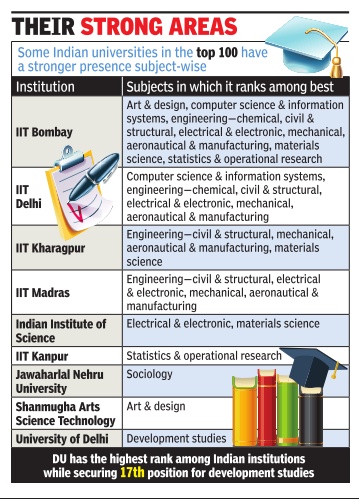
The Times of India, Apr 30 2015
Manash Gohain
DU, JNU, IIT depts make it to global top 100 list
Nine Indian varsities in QS rankings within nine disciplines
Indian universities might struggle to make the top 100 of the QS World University Rankings list, but their individual departments are amongst the best in the world. Delhi University tops the list, achieving the highest rank of all 20 Indian universities that have made the cut, while being placed 17th globally on the development studies subject table. Nine Indian institutions are listed in the top 100 within nine disciplines. In the QS World University Rankings by Subject 2015 published, India has secured 107 places across the 36 subject tables, including the six new disciplines for 2015--architecture, arts and design, business studies, dentistry , development studies and veterinary science.
IIT Bombay is the most prevalent Indian institute, appearing in the top 100 for eight subjects. IIT Delhi too has five of its departments in the top 100 while Jawaharlal Nehru University figures on one subject list. “This is a reflection of the progress made by Delhi University in four years.Rankings have improved in several disciplines. If we can keep up the momentum, we would be placed even higher next year,“ Malay Neerav, media coordinator, DU, said.
Within the inclusion of the new subject of art and design, Shanmugha Arts Science Technology and Research Academy , Thanjavur, has been placed in the top 100, while Indian Institute of Science, Bangalore, has made it for materials science and electrical and electronic engineering. From Delhi, IIT also appears in the top 100 for civil and structural engineering, electrical and electronic engineering, mechanical aeronautical and manufacturing engineering and computer science and information system.
However, in business and management studies, none of the B-schools could make it into the top 100. The top ranks in this subject table are shared by IIM Ahmedabad, IIM Bangalore and IIT Delhi.
2015: Number of women vice-chancellors
The Times of India, Jun 05 2015
Chethan Kumar
Only 13 of India's 431 universities have women VCs
The prestigious Oxford University announced that Professor Louise Richardson, subject to approval, could go on to become the university's first woman vice-chancellor in its 800-year-old history . Down in India, things are not too different. Multiple studies reveal the percentage of women vice-chancellors here is a shocking 3%, with just 13 universities of the 431, a UGC study surveyed, having women running a varsity . This, despite girls outdoing boys year after year in exams, and women constituting more than 50% of teaching posts in universities.
According to a British Council commissioned report titled `Women in Higher Education Leadership in South Asia: Rejection, Refusal, Reluctance, Revisioning', the percentage of women teaching staff drops drastically at higher levels. “Women constitute only 1.4% of the professoriate, though there are many at other positions like readers, lecturers etc,“ the report released in February 2015 notes.
Adding that even of the 13 women VCs, six are from allwomen universities, the report flags the culture of discrimination. “There are many reasons -from the way selection committees are constituted to the way women and men think. Most women academicians are more passionate about teaching than running institutions, which is why many of them, although qualified, do not choose to apply for such posts,“ Meena Rajiv Chandawarkar, VC , Karnataka State Women's University, told TOI.
Quoting a UGC-constituted task force in 2013, the report says, “Glass ceilings and fears over promotion must receive more attention, the feedback indicates widespread practices of discrimination and harassment among women working in higher education institutions.“
Berin Lucas, sociology professor of St Joseph's College of Arts and Science says, “Higher education must open its doors to new learning, but it is only a reflection of the patriarchal fabric of society , which operates in every spectrum of life, not even exempting education.“ The report, though, paints a bright picture at the under-graduate level for women.
2015: IIS, Bangalore; IIT, Delhi in Top 200
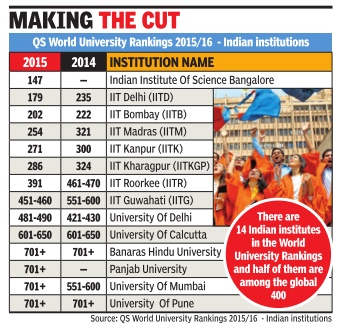
The Times of India, Sep 15 2015
Kounteya Sinha
In a 1st, 2 Indian institutes make it to world's top 200
Two Indian institutes have for the first time made it to the top 200 list of the world's best universities. The Indian Institute of Science, Bengaluru, has taken the top spot among its Indian counterparts, bagging the 147th rank. The only other Indian institute to make it to the top 200 is Indian Institute of Technology Delhi, ranked 179th this year. It has made great progress from last year when it was ranked 235th in the world.
According to the QS World University Rankings 2015, there are 14 Indian institutions in the World Uni versity Rankings and half of them are among the global 400. The bad news is that the University of Delhi and the University of Mumbai have lost ground.
The Massachusetts Institute of Technology (MIT) is the world's top university , closely followed by Harvard.The University of Cambridge is tied to Stanford Uni versity for the third place.London is the only city in the world with four universities in the top 50, more than Boston and New York (3) Paris, Sydney , Hong Kong and Beij ing (2), with the London School of Economics and Po litical Science making the top 40 for the first time.
In an exclusive interview to TOI, Ben Sowter, QS head of research, said, “India has two institutions in the top 200 this year, which has occurred as a result of QS evolving its methodology to be more even-handed across subject areas and it has revealed strength in research in engi neering, technology and the natural sciences. If you want to compare India and China, the primary shortfalls are money and consistent policy leadership.“
Thirty-four countries are represented in the top 200.
The US is the dominant nation, with 49 institutions, ahead of the UK (30), the Netherlands (12), Germany (11), Canada, Australia, and Japan (8), China (7), France, Sweden and Hong Kong (5).
2015: Times Asia rankings
The Times of India, Jun 11 2015
Manash Gohain
Only 9 Indian univs make it to Times Asia rankings 2015
China beats Japan, heads top-100 list
Indian Institute of Science, Bangalore upstaged Panjab University as India's number one university, while IISc and IIT,Bombay , were the two new entrants in the top 100 of the Times Higher Education University Asia Rankings 2015, released on Wednesday . However, there is cause for concern as this year only nine Indian universities made it to the top 100, down from 10, whereas IIT-Guwahati, IIT-Kanpur and Jadavpur University-which made it to the top 100 comfortably last year-have exited the rankings altogether this time. Meanwhile, China has overtaken Japan as the Asian power house in education, but Japan's University of Tokyo is still in the numero uno position.
IISc-Bangalore entered the table at 37th, one place ahead of last year's leader, Panjab University , whose rank fell from 32. Five IITs, led by IIT-Roorkee (joint 55th) formed the lion's share of the country's representation, although Aligarh Muslim University (90th) and Jawaharlal Nehru University (96th) too made it to the top 100.
Phil Baty , editor of The Times Higher Education Rankings, said, “It is cause for concern that India has lost ground in the league ta ble. Most of last year's representatives have fallen down the list. With India's major chunk of population under 25 years of age, it is more crucial than ever for India to invest in research and strengthen its academic links with other nations. “ The Asia rankings use 13 performance indicators to examine each university's strengths against its core missions of teaching, research, knowledge transfer and international outlook.Besides seeding its position to China, many of Japan's representatives have lost ground, with only 19 universities in the list, down from 20 last year and 22 in 2013.
China now has 21 representatives in the top 100, going past Japan for the first time, with three of its universities as new entrants. Last year China had 18 universities and 15 in 2013. Both Peking University (fourth) and Tsinghua University (fifth) have moved up a place.
Hong Kong University managed to retain its third place and had a strong presence from the Chinese special administrative region, with all six of its universities in the top 50. The Hong Kong University of Science and Technology rose from ninth to seventh, while the Chinese University of Hong Kong stood at 13th.
“The world expects Asia to be the next global higher education superpower after Europe and North America.Times Higher Education data shows many of the continent's leading universities competing on equal terms with the best in the West,“ said Baty .
2015: QS World Universities ranking
The Times of India, Sep 24 2015

QS WORLD UNIVERSITY RANKINGS 2015-16 - INDIAN UNIVERSITIES AMONG WORLD'S TOP 200
Since its launch in 2004, the QS World University Rankings remains a major news event around the world. And they matter enormously to academics, university managers, students, alumni and other key groups in higher education. As with any ranking, the big names near the top are the first to attract attention. We find that the Massachusetts Institute of Technology is still the world's top university. It has near-perfect scores on five of our six measures, but falters on our indicator for international students where it gains a mere 95.5 out of a possible 100. It is 62nd in the world on this measure. In second place is Harvard, which also performs extremely well in all the indicators, except for the proportion of international students. The top 20 we see here is dominated as usual by an array of household-name institutions in the US and the UK. US universities take 10 top-20 places and the UK five. Two of the others are in Switzerland, two in Singapore and one in Australia.
There is bound to be close attention to the effects of this year's major improvement to the rankings, the faculty-level normalisation of our citations count. The intention is to counteract the ferocious publish-or-perish culture of the biomedical field, and in the natural sciences, by equalising the effect of citations in the major areas of academic life.
For this year, its effects can be seen most starkly in the improved standing of institutions with a strong emphasis on the social sciences and the arts and humanities. Most striking is the rise of the London School of Economics from 71st place to 35th, driven by a rise in its citations ranking. In general, the effect of this change on large universities with a comprehensive range of subject provision ought to be broadly neutral.This applies to most of our topranked institutions, so there have been few if anyearthquakes in the upper reaches of these rankings.
However, universities with a strong emphasis on the biomedical sciences lose the advantage afforded by our previous methodological approach in counting citation per faculty.
The most visible example is Imperial College, London. It has fallen from the number two position to eighth. The main reason is indeed the fall in its citation per faculty member indicator, as a result of the normalization applied to this measure. This is the only one of our six measures on which Imperial does not have a near-perfect score.
The other startling result near the top of these rankings is the rise of Nanyang Technological University in Singapore. NTU is up 26 places to 13th, one place behind the National University of Singapore, making NTU much the newest top university in the world.In addition, it has proved possible for medicine-intensive universities to offset the effects of the citations changes by improving elsewhere. Examples include Johns Hopkins and Yale in the US. They both lost out in the citations reform, but have fallen less than might have been expected by doing better on other measures.
This new approach to citations allows us to look afresh at the relative standing of world higher education systems. One example is the possible rise in the standing of Asian higher education. Across the region, universities have been the focus of massive political emphasis, and of substantial financial investment. We have already seen that Singapore's commitment to learning and research is a success, with two top-20 universities in this ranking.
These rankings show little material change in the standing of universities in Japan, Korea or Taiwan. The main winners are in China and India. China's two top institutions, Tsinghua and Peking universities, are up by 22 and 16 places respectively to 25 and 41. In India, seven of the Indian Institutes of Technology are up this year including top-rated IIT Delhi (179th) which breaks into the Top 200 for the first time ever. As a general rule, engineering and technology attach less importance to citations than science and medicine. The top Indian institution is the Indian Institute of Science Bangalore. It is a new entry at a praiseworthy 147, having satisfied QS that its work is broadly-based enough to be included in our global ranking.
Ben Sowter, QS head of research says “India's universities have clear strengths in technology and natural sciences, and with the historic emphasis on medical research now neutralized, are reflected in their rightful place in this year's tables. On a cautionary note, however, it's important to highlight that the trend in a number of key measures remains downward, so to retain and improve upon this year's results, the Indian Higher Education establishment must not be complacent, and must continue to drive for greater international recognition.“
There are 14 Indian institutions in the QS World University Rankings and half of them are among the global 400. While the IITs and the Institute of Science have all progressed in this edition, the large comprehensive universities, such as the University of Delhi and the University of Mumbai have lost ground, principally because of the normalisation by faculty applied to the research indicator but also due to deterioration in other dimensions as well.
The University of Delhi features among the world's top 200 in the Social Sciences & Management (191th) and Arts & Humanities tables (176th) while Jawaharlal Nehru University is the leading Indian university in this area (168th). Unsurprisingly, Indian institutions excel in the Engineering & Technology area, with five IITs among the Top 100 in the world while they also have a fairly strong profile in the Natural Sciences.
2015: 17 Indian institutions in Times' top 800
The Times of India, Sep 30 2015
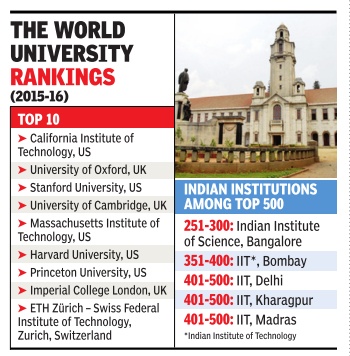
Manash Gohain
17 Indian institutions among Times' top 800
India put on a better show than previous editions at The Times Higher Education World University Rankings 2015-16, to be released on Wednesday , after the list was expanded to top 800 from 400. But none of them breached the top 200.
The highest ranked institution is the Indian Institute of Science, Bangalore, placed in 251-300 rank group and the other institution among the top 400 is Indian Institute of Technology , Bombay (351-400 cohort). In all, India has 17 universities in the list, matching its BRIC counterpart Brazil. Among Asian countries, China continues to dominate, while Japan and South Korea have fallen behind.
Phil Baty , editor of the Times Higher Education World University Rankings, said: “India will have to work harder to compete with other emerging economies such as China, which has 37 institutions, and Russia which has fewer institutions overall but a higher proportion in the upper echelons of the table.“
“With the population of young people in the country expanding, resulting in further pressure on resources, it is now more crucial than ever that India invests in research and strengthens its links with other nations. The Centre is yet to implement an initiative in this area,“ he said.
In Asia, the National University of Singapore holds the number one spot (in 26th place), while China's Peking and Tsinghua universities are at 42nd and joint 47th respectively .
See also
Education: India (covers issues common to all categories of Education) <> Engineering education: India <> Higher Education: India <> Medical education: India <> Primary Education: India <> School education: India (covers issues common to Primary and Secondary Education) <> Secondary Education: India <> [[South Asian universities: global ranking ]]<>Indian universities: global ranking …and many more.
